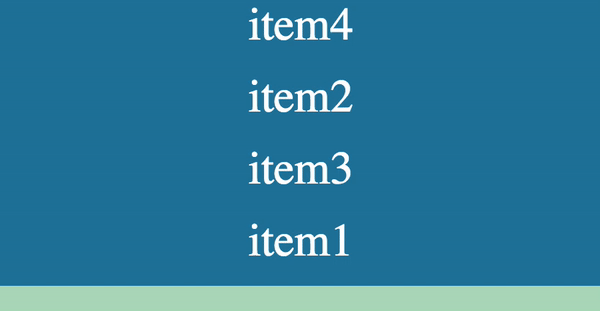npm install react-spring
react-spring is a cooked down fork of Christopher Chedeau's animated (which is used in react-native by default). It is trying to bridge it with Cheng Lou's react-motion. Although both are smilar in that they are spring-physics based, they have their pros and cons and could definitively benefit from one another:
| Declarative | Primitives | Interpolations | Performance | |
|---|---|---|---|---|
| React-motion | ✅ | ✅ | ❌ | ❌ |
| Animated | ❌ | ❌ | ✅ | ✅ |
| React-spring | ✅ | ✅ | ✅ | ✅ |
react-spring inherits react-motions api (and simplifies it), has lots of primitives (springs, trails, transitions, reveals, parallax), can interpolate mostly everything (colors, gradients, percentages, degrees, svg-paths, arrays, etc.) and last but not least, can animate by committing directly to the dom instead of re-rendering a component frame-by-frame.
import { Spring, Transition, Trail, Parallax } from 'react-spring'Springs (Demo)
A Spring will move data from one state to another. It remembers the current state, value changes are always fluid.
<Spring from={{ opacity: 0 }} to={{ opacity: 1 }}>
{styles => <div style={styles}>i will fade in</div>}
</Spring>Mount/unmount Transitions (Demo)
Transition watches elements as they mount and unmount, it helps you to animate these changes.
<Transition
keys={items.map(item => item.key)}
from={{ opacity: 0, height: 0 }}
enter={{ opacity: 1, height: 20 }}
leave={{ opacity: 0, height: 0 }}>
{items.map(item => styles => <li style={styles}>{item.text}</li>)}
</Transition>2-state Reveals (Demo)
Given a single child instead of a list you can reveal components with it.
<Transition
from={{ opacity: 0 }}
enter={{ opacity: 1 }}
leave={{ opacity: 0 }}>
{toggle ? ComponentA : ComponentB}
</Transition>Trails and staggered animations (Demo)
Trail animates the first child of a list of elements, the rest follow the spring of their previous sibling.
<Trail from={{ opacity: 0 }} to={{ opacity: 1 }} keys={items.map(item => item.key)}>
{items.map(item => styles => <div style={styles}>{item.text}</div>)}
</Trail>Parallax and page transitions (Demo)
Parallax allows you to declaratively create page/scroll-based animations.
<Parallax pages={2}>
<Parallax.Layer offset={0} speed={0.2}>first Page</Parallax.Layer>
<Parallax.Layer offset={1} speed={0.5}>second Page</Parallax.Layer>
</Parallax>Additional demos: Vertical scroll | Gestures | Routing | Graphs | TodoMVC | Drag/n/drop
For a raw documentation of all possible properties look here.
You can interpolate almost everything, from numbers, colors, svg-paths, percentages, arrays to string patterns:
<spring to={{
scale: toggle ? 1 : 2,
start: toggle ? '#abc' : 'rgb(10,20,30)',
end: toggle ? 'seagreen' : 'rgba(0,0,0,0.5)',
stop: toggle ? '0%' : '50%',
rotate: toggle ? '0deg' : '45deg',
path: toggle ? 'M20,380 L380,380 L380,380 Z' : 'M20,20 L20,380 L380,380 Z',
vector: toggle ? [1,2,50,100] : [20,30,1,-100],
}}>Don't like the way render props wrap your code?
const Header = ({ children, bold, ...styles }) => (
<h1 style={styles}>
{bold ? <b>{children}</b> : children}
</h1>
)
<Spring render={Header} to={{ color: 'fuchsia' }} bold>
hello there
</Spring>Et voilà! Header animates on prop changes! Props that Spring doesn't recognize will be spread over the receiving component, in this example bold, but it also includes children if you use render to refer to the render-child.
Native rendering (Demo)
By default we'll render the receiving component every frame as it gives you more freedom to animate. In situations where that becomes expensive add the native flag and animations will now be applied directly to the dom. The flag is available for all primitives (Spring, Transition & Trail, Parallax is native by design).
Just be aware of the following conditions:
- It only animates element styles and attributes, the values you receive are opaque objects, not regular values
- Receiving elements must be
animated.[elementName], for instancedivbecomesanimated.div - If you need to interpolate styles use the
templatestring literal
import { Spring, animated, template } from 'react-spring'
<Spring native to={{ path, rotate, scale }}>
{({ rotate, scale, path }) => (
<animated.svg style={{ transform: template`rotate(${rotate}) scale(${scale})` }}>
<g><animated.path d={path} /></g>
</animated.svg>
)}
</Spring>Animates children as they mount and unmount. from denotes base styles, enter styles are applied when objects appear, leave styles are applied when objects disappear. Keys and children have to match in their order! The keys are the same that you would provide in any other looping situation.
import { Transition } from 'react-spring'
<ul>
<Transition
keys={items.map(item => item.key)}
from={{ opacity: 0, height: 0 }}
enter={{ opacity: 1, height: 20 }}
leave={{ opacity: 0, height: 0 }}>
{items.map(item => styles => <li style={styles}>{item.text}</li>)}
</Transition>
</ul>You can use this prototype for two-state reveals, simply render a single child that you can switch out for another. You don't have to pass keys for this one.
<Transition
from={{ opacity: 0 }}
enter={{ opacity: 1 }}
leave={{ opacity: 0 }}>
{toggle ? ComponentA : ComponentB}
</Transition>Trail animates the first child of the list you pass, the others will follow in a trailing motion. The api is similar to Transition though it will assume your list is fixed.
import { Trail } from 'react-spring'
<Trail from={{ opacity: 0 }} to={{ opacity: 1 }} keys={items.map(item => item.key)}>
{items.map(item => styles => <div style={styles}>{item.text}</div>)}
</Trail>Parallax creates a scroll container. Throw in any amount of layers and it will take care of moving them in accordance to their offsets and speeds.
Parallax.pages determines the total space of the inner content where each page takes 100% of the visible container. Layer.offset determines where the layer will be at when scrolled to (0=start, 1=1st page, ...). Layer.speed shifts the layer in accordance to its offset, values can be positive or negative.
import { Parallax } from 'react-spring'
<Parallax pages={3} scrolling={false} horizontal ref={ref => this.parallax = ref}>
<Parallax.Layer offset={0} speed={0.5}>
<span onClick={() => this.parallax.scrollTo(1)}>
Layers can contain anything
</span>
</Parallax.Layer>
</Parallax>




